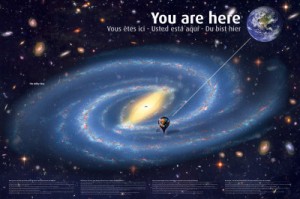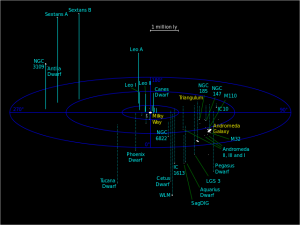The universe is everything that exists physically, the entirety of space and time, all forms of matter, energy, and momentum, and the physical laws and constants that govern them. The age of the universe is believed to be approximately 13.7 billion years, and scientists estimate that the diameter of the observable universe is at least 93 billion light years.
The Earth is part of the solar system. The solar system exists in the Milky Way galaxy. The sun is one of the stars in the Milky Way, and the only reason it looks bigger than all the other stars, is that it is so close to us. There are 100 billion (1011) stars in the Milky Way and 100 billion galaxies in the observable universe, so there are approximately 1022 stars in the observable universe, and many of them have planetary systems similar to our solar system. Therefore, the possibility that life exists out there somewhere must be very high.
Scientists estimate that the universe is made up of 4 per cent ordinary matter, 26 per cent dark matter, and 70 per cent dark energy. (These figures may vary somewhat depending on the source.) My own belief is that the percentage of ordinary matter is much less than 4 per cent of the total and that it may actually be infinitesimal. However, for the purposes of presenting my arguments, I use the 70/26/4 per cent estimate.
Many scientists now accept that the universe started with the ‘Big Bang’, the primeval explosion that brought all space and time, all matter and energy, into being. In 1931, Monseigneur Georges Lemaître proposed in his hypothèse de l’atome primitif (hypothesis of the primeval atom) that the universe began with the ‘explosion’ of the ‘primeval atom’. This theory later became known as the Big Bang Theory. The Big Bang attempts to explain how the universe developed from a tiny, dense state into what it is today, but this theory is merely a model to convey what happened in the beginning, not a description of an actual explosion. An explosion is slightly misleading in that it conveys the image that the Big Bang was triggered in some way and at some particular point in space and time. However, the same pattern of expansion would be observed from anywhere in the universe, so there is no particular location in our present universe which could claim to be the origin. The Big Bang really describes a very rapid expansion or stretching of space itself, rather than an explosion in pre-existing space.
However, for three primary reasons, this model regarding the origin of the universe makes little sense.
Reason 1
The Big Bang model predates scientists’ realisation that dark energy and probably dark matter exist, so it must be based on a purely physical universe, which is only 4 per cent of the whole. To suggest that the origin of the universe is based on 4 per cent of reality makes little sense.
Reason 2
Scientists believe that all four forces were united in the Planck epoch. If the four forces became united at the present time, there would be no gravity to keep all the celestial bodies in existence, there would be no electromagnetic force to bind atoms and molecules, and there would be no strong force to bind the elementary particles or to bind the nuclei of atoms. Therefore, all matter would return to elementary particles, such as electrons and quarks. The elementary particles would then return to the ‘stuff’ that existed in the Planck epoch, which would then account for 100 per cent of the whole.
However, there is no logical argument to suggest that the ‘stuff’ of the Planck epoch would then return to an infinitesimally small sphere. In my view the concept of this ‘infinitesimally small sphere’ is rooted in the belief that the universe is a purely physical phenomenon. However, since scientists now believe that only 4 per cent of the universe is physical, I believe that we should look to the 96 per cent, rather than the 4 per cent, to understand the origin of the universe.
Reason 3
I believe that for any ‘live system’ to exist it must obviously have a source, but critically, that source must continue to play a role for the lifetime of the system by interacting with it, and renewing it on a continuous basis.
A simple analogy to explain this principle is the water cycle. Without getting too complex, the water cycle can be simply explained as follows; water vapour evaporates from the sea and fills the entire atmosphere. When conditions allow, this water vapour condenses to form clouds and the clouds then fall back to the sea as rain. In this analogy, the sea is the source, the water vapour is the non-physical (pre-particle) ‘stuff’ and the clouds are the physical universe. Now, if the sea had completely evaporated in its effort to make the clouds, then the cycle would break down and the system would die.
However, the Big Bang theory requires that the primeval particle (the source) is completely ‘used up’ in the act of creating the universe and therefore ceases to exist as a source. In my view that is completely illogical.
In my book, Dark Energy and Human Consciousness, I suggest an alternative model to explain the origin of the universe; and the source in that model constitutes 100 per cent of reality.
Recent Posts
- Scientific Support for Brexit July 5, 2018
- The Evolution of Human Consciousness November 12, 2015
- Will Science Retreat into a Cul de Sac – just as Theology did before them? September 22, 2015
- Corruption and Abuse of Power are the Source of all the Major Problems in our World September 9, 2015
- A United Europe. Is it a crazy idea? – or – Is it a necessary step in the evolutionary journey of the human race? August 11, 2015
- A New Scientific View of Reality based on The Grand Interactive Model June 9, 2015
- Humanity can create a world dominated by Love, Care, and Compassion April 13, 2015
- The Origin and Evolution of the Universe – The Grand Interactive Model November 28, 2014
- The roles science and theology have played in creating our present world of pain and suffering November 25, 2014
- Science and Theology – A Common Understanding November 18, 2014
Archives
- July 2018 (1)
- November 2015 (1)
- September 2015 (2)
- August 2015 (1)
- June 2015 (1)
- April 2015 (1)
- November 2014 (6)
- October 2014 (6)
- July 2014 (1)





Recent Comments